ok so here's a more organized presentations of the 1:1 zoom pics than on flikr as promised.
as i
argued here with yet unknown success, the effective magnification factor on these crops - without "digitally zooming" beyond 1:1 pixel ratio - is effectively 700x; due to the unusual fact that we are limited to 500px width on flikr (e.g. the full-size pics were severely shrunken). obviously the apparent visual quality has worsened significantly at 1:1 pixel zoom as a result - some of that is due to the fact that 1:1 pixel zoom just isn't very pretty due to the camera's bayer pixel pattern, and some due to straining the limits of the optics. but by far the bulk of the reason for the poor image quality is simply due to the fact that the 400mm lens is already exceeding the useful magnification for the distances involved, due to the atmospheric haze and shimmer and other distortion of even these most nearly "perfect" pacific coast days. my optical lens doubler and 50x stabilized binoculars made that much *very* clear, no pun intended. (or as bishop is stupidly font of saying: there too many atoms to look through.) fortunately, it is not too obscured to see that very large-scale objects are clearly "sunken" and "restored" (or clearly not). also since the horizon is usually much closer depending on the elevation of the shot, it is usually razor sharp.
the "700x effective magnification" argument may or may not be valid, i certainly won't pretend it is without more expert weigh-in. i'd like to hear what max thinks about it, for starters. if you have an opinion on the argument or want to see the assumptions, calculations, and more arguments behind it, click on the link above.
either way, the 700x argument doesn't matter to the evidence;
the evidence is what it is, and shows what it shows: magnification does not restore the islands, cargo ships, or bridges. (even on the island series of several shots covering a
1,733x increase in magnification factor, over two cameras, taken at the same time, location, and elevation.)
the evidence also clearly demonstrates that
increasing your viewing elevation *does* fully "restore" sunken islands, boats, and bridges.finally, although this is not about the bishop troll, the evidence also proves conclusively that he lied about his beach story. just made it up. before this, just simple reason (
e.g., kids splashing in the water in 55 degree water on a chilly day, and being able to resolve a frisbee) already told us that it was just a bunch of convenient made-up shit. not to mention the fact that after a month of nearly daily badgering to just
commit to
someday providing the photographic evdidence, he repeated weasled out of doing so. which of course is no surprise, we already knew that bishiop is a
compulsive liar and a
serial self-contradictor anyway.
but on to the photos:all photos are all hotlinked to their flikr sources, with full description of location, elevation, exact date/time, focal length, camera make and model, relative ordinal position in their originally intended photos series, tag-linked to google earth screenshots (for visual location reference), tag-linked to their original but greatly shrunken counterparts, and finally, all with full camera exif data available through the appropriate flikr links.1) this first pic shreds, once and for all, bishop's "
viewing the beach from 33 miles away" bs. even as viewed form 120 ft. elevation, and from just 10.0 miles away, there is not enough angular resolution, and too much haze, to discern people. much less frisbees. even at 10 mp, people are less than one pixel high (there did seem to be people there - motion and the occasional glint seemed to confirm that at the time, plus it is one of the most popular beaches in the bay area).
bishop's telescope has a resolving power of 1.03arc*sec. anyone should be able to bust out the trig and calculate 1) could he resolve, with eye on telescope, the difference between a child and a teenager from 33 miles away; and 2) could he resolve a frisbee vs. something else such as a boomerang or softball.
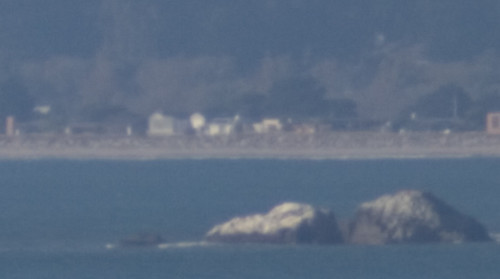 2) cargo ship - elevation comparisons
2) cargo ship - elevation comparisons the following sereis of three shots (from an original series of 6) is of a large cargo ship (or it could be a oil tanker...my girlfriend would know but i'm embarrassed to get her in on this), at an unknown distance but i'm estimating it at about 10 miles (it seemed less than half-way in between myself and the farallon islands at a known 28 miles away, when viewed from a high enough elevation and allowing for perspective).
2.a) shot from approx 4 ft. above water level. notice that the horizon appears comparatively "closer", sharper, and more raggedy due to minor undulations of the water (on an otherwise low-surf day). not to mention, the fact that at 624mm (35mm effective) zoom, or effectively 700x magnification, the ship is clearly, unambiguously on the other side of, mostly below, and much farther than - the horizon.
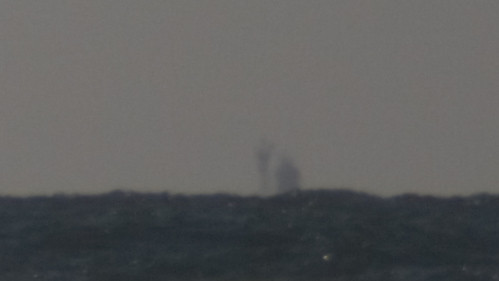 2.b)
2.b) shot from approx 25 ft. above water level. zomg, it is starting to un-sink itself! notice how the horizon seems farther away (but still significantly closer than the ship), smoother, and a little less sharp.
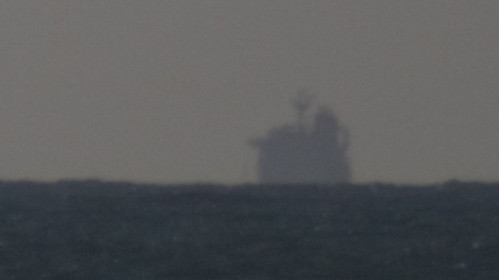 2.c)
2.c) shot from approx 150 ft elevation.
fully "restored". horizon line is behind the ship, farther away and hazier than the ship, very smooth, and significantly less optically sharp.
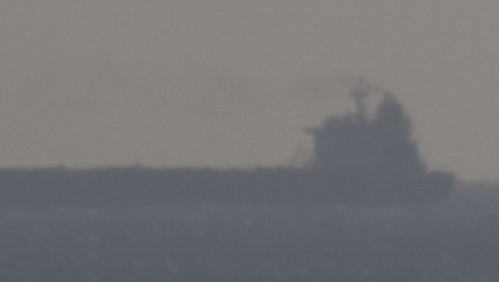 3) different cargo ship, different day - magnification factor comparisons
3) different cargo ship, different day - magnification factor comparisons both shots are from the same location and approx 12 ft. above water level. i roughly and indirectly estimated the distance to be 15 miles, based on its relative size in image compared to previous series [assuming similarly sized ship], whose distance in turn was estimated relative to its location more directly between the farallon islands [of known distance] and the shot location.
3.a) shot from 12 ft. above water level at focal length of 320mm (35mm effective). looks slightly "sunken". notice, even this is clearly past the useful limit of angular resolution due to atmospheric haze (on a fantastically clear ca pacific coast day), for resolving any useful detail other than large shape outlines and the horizon line.
 3.b)
3.b) shot with twice as much magnification power. still
exactly as "sunken", proportionally.
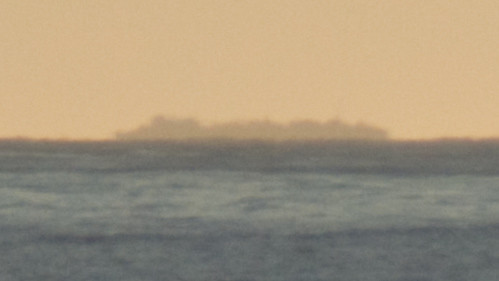 4) same cargo ship as immediately above - but elevation (rather than magnification) comparisons
4) same cargo ship as immediately above - but elevation (rather than magnification) comparisons all shots are made with a focal length of 624mm (35mm effective).
4.a) shot from approx 6 ft above water level. we can just see the top sticking above the horizon.
(note: i didn't have a raw file for this one for some reason. [i often switch between raw+jpeg and jpeg-only modes, and have a "hot-button" remapped for that purpose - due to card space concerns, as well as other reasons such as capturing panoramas or rapid-fire sequential action shots without filling up the card and waiting forever.] this is a jpeg straight off the camera, but still internally processed by the internal digic chip for more contrast, plus some sharpening applied, and some other subtle things such as post-contrast noise-reduction.)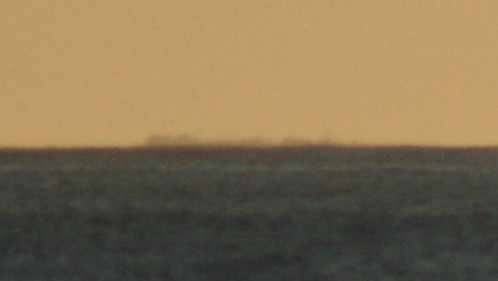 4.b)
4.b) shot from approx 12 ft. above water level. whadday know, a ship seems to be emerging from the depths...or from below the horizon, whatever floats your boat.
 4.c)
4.c) shot from approx 30 ft. above water level.
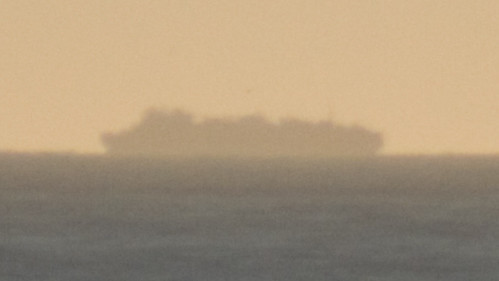 5) farallon islands - zoom comparisons (covering 1,733x spread in magnification factor).
5) farallon islands - zoom comparisons (covering 1,733x spread in magnification factor). the islands are 28 miles away. all shots are from the same location and 300 ft. elevation, with two different cameras having very different lenses and sensor sizes. (a canon digital rebel xti + tamron 200 - 400mm lens; and a canon powershot s5 is, with built-in 12x zoom lens.) as usual, all focal lengths are normalized to 35mm equivalent necessary for comparison with very different sensor sizes, and for ease of repeatable methodology by others people with cameras of potentially very different [focal length number : actual fov] properties.
5.a) 36mm. the islands are very small in the frame even at this extreme crop level. they look partially sunken.
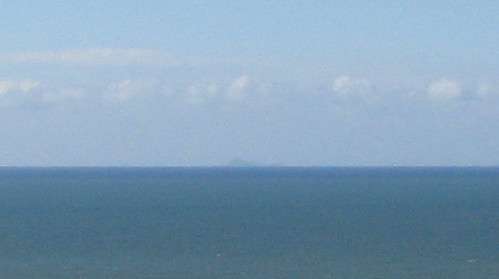 5.b)
5.b) 126mm. the islands appear three and a half times larger in the frame as in the previous shot, yet are no more "restored".
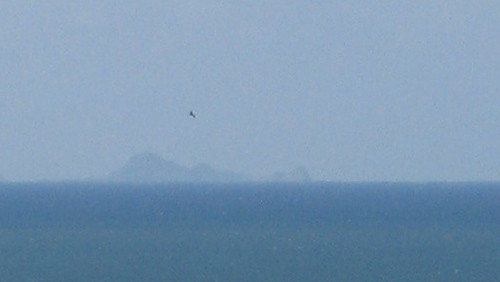 5.c)
5.c) 432mm. again, we have a nearly three and a half times increase in magnification factor over the immediately previous image. the islands extend well past the severely cropped viewing frame, but are still not "restored" in the slightest. i chose to center on the nearly sunken middle portion, since some have used that area in other, previously posted images for enhancement analyses.
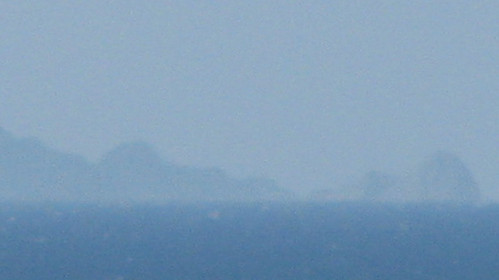 5.d)
5.d) 624mm. nearly one and a half times increase in magnification factor over the immediately previous image. the island is engulfed by the severely cropped frame.
it is still just as sunken.also note there are
no children visibly splashing in the water, nor frisbees in the air. (although there is no beach nor human population to speak of on this approx 1.5 km visible oblique stretch of ragged rocky "coast", even if such a beach wouldn't be clearly below the horizon. at any rate we certainly have not even
remotely enough visibility due to the haze and distortion of 28 miles of dense atmo - even on a fantasically clear pacific coast day as this, and at an effective 700x crop to 1:1 pixel zoom - to see, say for example, sea lions or even any of the larger [than a frisbee] birds up higher on the island, who frequent it so much that the islands are plastered white.
bishop's "33 mile away beach" yarn debunked again.
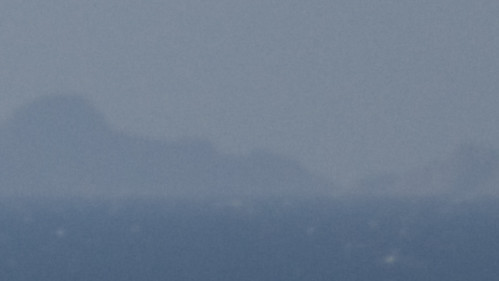 6) farallon islands from a lower elevation - focal length comparisons
6) farallon islands from a lower elevation - focal length comparisons both shots from same location and 245 ft. elevation.
6.a) 328mm (35mm equiv) focal length. the island is partially "sunken". particularly, the part in the middle (visible in part or total in other shots) is beyond and below the horizon.
 6.b)
6.b) exactly twice the focal length as above. the island is not restored - and again, we are beyond the usefulness of more magnification being able to resolve more detail, due to atmospheric conditions.

edit: fixed zoom calc link